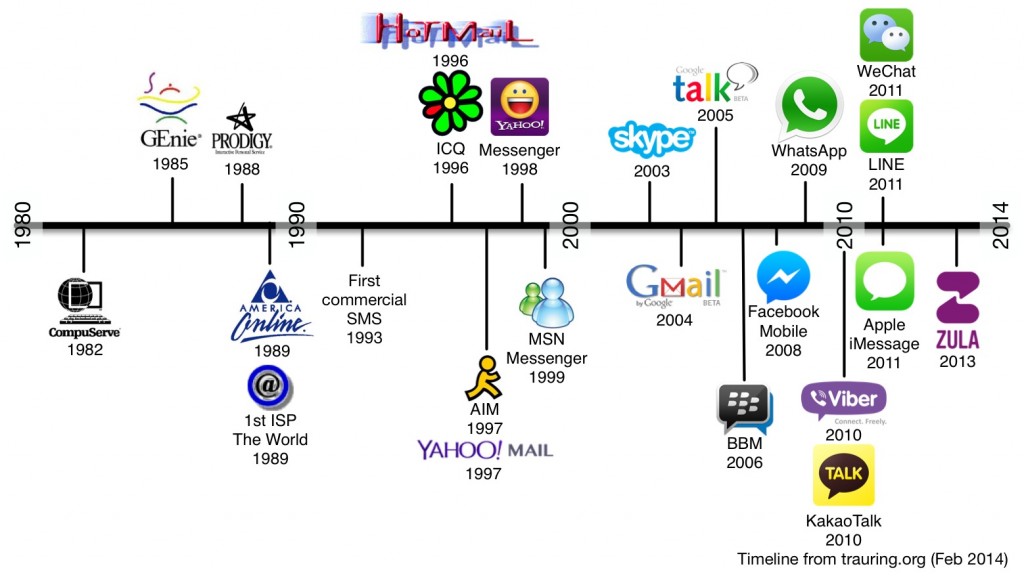
There are in my view four main phases in the history of online and mobile messaging.
The first phase included e-mail and to some extent real-time messaging (in the form of chat rooms), but was strictly within walled gardens. You could only communicate with others using the same proprietary service provider (America Online, Compuserve, Delphi, etc.).
The second phase was the beginning of interconnected systems and the Internet. E-mail no longer stayed on a single server, but could go between companies. Real-time messaging, switched from chats that people had to join, to curated lists of friends, the buddy list, which dictated who you could chat with and allowed people to know when you were available for chat. To chat with someone you needed to know their username (or be able to find it in a directory). In some implementations, such as MSN Messenger, the other user had to approve you being able to see if they were online, but in others like AIM, you could see who was online as long as you knew their username (assuming they had not blocked you).
The third phase was the emergence of text messaging on cell phones. This includes SMS, which spread initially in Europe before becoming popular in the US. Initially text messages were limited to other people on the same carrier, not that different than e-mails on the early online services. As SMS started working across networks it spread very quickly, becoming used more than voice calling for certain populations, certainly among teenagers at the time. One could argue that phases two and three were largely concurrent. ICQ launched in 1996, roughly the same time as SMS made it onto cell phones.
In the fourth phase, which we’re now in, e-mail and real-time messaging have to some extent merged. Facebook Messenger perhaps is the best example of this, where there is no real differentiation of real-time message and e-mail. If you don’t see the message now, you’ll see it later. In addition, messaging applications are removing the need to curate your contact list, and making all your contacts who use their software available for you to message. Whatsapp does this really well, and Facebook Messenger now also does this in some fashion. There is no need to know any kind of special username for these systems, knowing some other associated contact detail such as the person’s phone number or e-mail address is enough. On one hand, this presumes somewhat more familiarity with the person, on the other hand you can’t have a messaging account that uses a made up username that is only used for that purpose. A little noticed aspect is that these new messaging systems are moving back into a walled garden approach.
A bit of history, to give perspective on the current state of messaging. Caveat: Don’t think of this as a comprehensive history, it’s filtered through my memory and perspective.
Proprietary Online Services
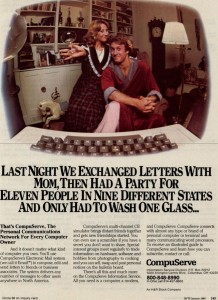
While there was e-mail and real-time messaging on these services, they were for the most part self-contained – if you were on Compuserve you couldn’t message someone on Delphi. In the BBS world, some interaction between sites emerged in the form of FidoNet (and the lesser known WWIVnet). While these services and bulletin boards served millions of users at their peak, they were quickly replaced by Internet service providers who had no need to create the content and manage forums like the legacy services. The new generation of Internet providers had another distinct advantage over the legacy companies – they were all connected through standard protocols. E-mail from any Internet provider could reach anyone on any other Internet provider.
Most of those services are now obscure footnotes in the history of tech, at least in their original forms (AOL obviously exists, but primarily as a content company. Compuserve is now a value brand of AOL (ironic considering how expensive Compuserve was originally), and Delphi exists as an online forum), but out of them sprang incredible innovation. GEnie had massively multiplayer games before most of the people playing them today were born. Compuserve invented the GIF format which was an important format in the early days of the web, then mostly disappeared for years due to patent licensing issues, before being revived recently to post annoying animations on social networks. Out of AOL (and Mirabilis, the Israeli company acquired by AOL that created ICQ) came what today we call Instant Messaging (buddy list based real-time communications).
Just a note on GIFs and the early days of online services. People who never used the early online services, or never used an early dial up modem (Compare 1200bps modem used in the early 1980s to a cable modem today running with a 12Mbps connection – that’s 12,000,000bps, or 10,000x the speed), don’t quite understand what it was like. Imagine waiting for each line of text to show up in sequence on the screen. GIFs would similarly render line by line, and you’d have to wait minutes just to see the simplest of images. I wish I could find an appropriate video to show what it was like, but needless to say it was a wholly different experience from what we have today.
One good thing that was mostly lost with the demise of these earlier online services was a sense of community. The forums run on these services engendered very loyal communities that generated wide ranging discussions on almost any topic. Perhaps thats why one of those services, Delphi, emerged as a web-based community site, with over 25 million discussions comprising over 300 million posts. People realized the true value of the service was the community. That’s another reason that early online communities like the The Well had (and perhaps still have) immense influence.
The Internet
My first e-mail account outside of one of these services and directly connected to the Internet was around 1990-91. I was working at Kurzweil Applied Intelligence and they had the domain kurz-ai.com (this being before the web was a marketing tool). I don’t remember my specific e-mail address. As it was 1990-91, there was no web to speak of really (Mosaic would not be released until 1993), and Gopher was just about the come into existence. The e-mail account was primarily for intra-company communications, although it was also used to communicate with other companies and institutions. Around this time I remember someone sending the first advertisement I had seen via e-mail. I wouldn’t call it spam because I think it was sent by someone at the company, but it led me to Eastgate Systems, a publisher of Hypertext fiction (and software), where I made by first e-commerce purchase (consider that this was before there was a commercial web).
Within a couple of years, every adult below a certain age had e-mail. Instant messaging was just starting to emerge. All university students received e-mail addresses (although as I recall my assigned e-mail address was actually based on my year of graduation AND the physical mailbox number I had in the school post office – luckily I also had one I could choose through the computer science department). Other people started getting e-mail addresses when their legacy online services connected to the Internet, and as they signed up for the new independent Internet service providers (who used standards based dial-up software, and generally provided no content). The first commercial ISP in the US (and they claim to be first in the whole world) was a service called, appropriately, The World, which was run by a company called Software Tool & Die in my hometown of Brookline, MA. That serviced launched in 1989.
In university I also remember a campus-wide messaging program that ran over AppleTalk. I don’t remember what it was called, but I remember each quad had its own network, and students used to chat up other students they didn’t know just because they were online (if you remember the name, please share it in the comments). Unlike the instant messaging applications that came later, this campus system had no buddy list, it just showed you who was connected at the time, separated by quad. That was about 20 years ago.
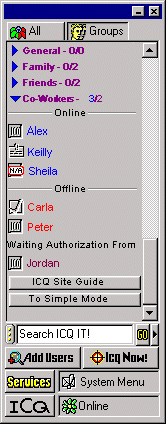
Jump ahead a few years, and instant messaging was huge. There was ICQ, AIM, MSN Messenger (discontinued and replaced with messaging within Skype), Yahoo, etc. The breakthrough of ICQ, launched in 1996, was that it was not tied to a paid service. The writing was on the wall – a year later AOL separated their instant messaging service from their paid online service and launched AIM. The following year AOL bought ICQ. Yahoo Messenger, MSN Messenger and others followed as well. AOL did a study in 2004 that showed that 70% of teenagers used instant messaging (like their own AIM) to communicate.
The separation from paid services hit e-mail at the same time, with the launch of Hotmail the same year as ICQ. Some would say that it was Hotmail being web-based that was significant, or that it was free, but really, as mentioned, it was the fact that it separated you from your paid carrier that was most significant. It created the possibility of having a permanent e-mail address for life. No wonder Microsoft snapped up Hotmail in 1997, and that Yahoo launched their own web-based e-mail product the same year. Web-based e-mail was about customer lock-in more than anything else. Integration between e-mail and instant messaging at this stage was basically non-existent. At most, you might have received notification of e-mails in your instant messaging application.
Google was just getting started at this time, and their initial product was obviously their search engine. They wouldn’t launch their e-mail product (Gmail) until 2004, and their first instant messaging product (Google Talk) until 2005. Google would launch their instant messaging product with two key features: One, that it was based on a standard protocol (XMPP) outside of their control (although not their influence). Two, that it could be used within their web-based e-mail product, Gmail, without needing a separate client. AOL had offered AIM Express, a web client, since 2004, however it just launched a window with a traditional AIM UI.
SMS and the Rise of Cell Phones
While it’s hard to imagine it today, you only have to go back to the mid-1990s when cell phones were only capable of voice communications. Short Messaging Service (SMS), the first standard for sending text messages from cell phone to cell phone, wasn’t available until 1993, and then only in a limited fashion. Most phones that supported SMS in the early days could receive, but not send messages. It was not until 1999 that text messages would be able to be sent between different networks, causing their usage to skyrocket. Eventually, as unlimited texting plans began to be offered by carriers, the usage of SMS would grow even more.
The availability of SMS grew with the availability and affordability of cell phones. For teenagers, who were beginning to get cell phone and were used to instant messaging on the computer, SMS allowed similar instant communications, but on the go. Text messaging grew among teenagers for several reasons. First, they were used to messaging using text. Second, texting in the early days was a bit of a pain without a full keyboard, so they had the patience to do it. Third, such short messages relied on shorthand which they were much more willing to rely upon. Clearly the features of SMS did not compare to that of instant messaging client on the computer, nor was it free at the beginning, so both were used concurrently for a long time until mobile Internet became a standard feature on cell phones, and messaging converged.
The Convergence
Recently, the trends have changed quite a bit. The rise of Facebook, and its messaging platform, seems to have hurt existing instant messaging platforms. There have always been clients (like Trillian and Adium) that could support multiple protocols (having AIM, ICQ, Yahoo, MSN and Google all running in the same window), but the reality is that once everyone you chat with is on one network, there’s no need to jump through those hoops anymore. Multi-network clients have never been able to fully take advantage of all the features of all networks, so if 90% of your contacts are on one network, chances are you’re just going to use their client. I used to have friends on AIM (mostly in the US), friends on MSN (mostly in Europe), a few friends on ICQ (mostly from Israel), and a few friends on Google. I didn’t really care since they all ran through Adium on my computer. Something happened, however, which slowly started changing how I connected to people.
First, AIM collapsed. There are a few reasons for this, and they’re probably a bit different in the details for different people. For me, my AIM screen name came from my original 1980s-era AOL account, which both of my parents had had accounts on, but who only my mother was still using. When my mother’s AOL account got overwhelmed by spam, she finally gave up on it and cancelled the account. Without the account it was linked to, my screen name which I had been using for decades (even before it was usable on AIM) went away. I already had a second AIM screen name, which I actually had set up to use Apple’s iChat video chat with a few friends, but eventually that screen name also failed, which had something to do with needing a security question added (I guess AOL was looking to improve their security). Since I used a third-party client, it took me forever to figure out what was wrong. The truth is, I didn’t really care, as I hardly used it. If I had not had alternatives to AIM, I probably would have worked harder to get it working again, but I did have alternatives, and thus did not. I’m sure others have had similar experiences in shedding their AIM account usage. With no base of users like it had when AOL was a major service provider, AIM usage dwindled to next to nothing. The messaging services that were connected to content and e-mail sites that people used every day did better, and thus MSN (until it was subsumed by Skype), Yahoo and Google took some of this market share. AOL sold off its ICQ division to a Russian company, where it maintains some marketshare in the Russian and East European market.
Second, the previously mentioned Facebook messaging. It took time for Facebook to get their messaging product up to spec, but for those with large Facebook networks, Facebook quickly overtook the size of most people’s buddy lists on other networks. People were on Facebook anyways, and the friends list started popping up conveniently on the right side of the page. In addition, Facebook did something brilliant, they merged instant messaging with longer e-mail-like messages, and kept an ongoing record of all communications between friends. Send a message and your friend just disconnected? No problem, they’ll see it when they’re back online. As Facebook went mobile, and people started checking Facebook messages on their phones, it finally became a very effective messaging solution, replacing the need to e-mail or IM your friends.
Third, the emergence of mobile-first messaging apps. It’s no secret that Facebook struggled quite a bit with their early mobile apps. They were slow and clunky. Their messaging offering also did not coalesce at first. Originally they handled messaging in their main Facebook app, and later separated into a separate app. One of the reasons they needed to separate it out, was to compete with the apps that started in mobile, when Facebook was still working on the web. The biggest mobile-first messaging app today is WhatsApp, which recently announced it has 430 million active users, and handles 50 billion messages a day. That itself is more than the number of SMS messages sent every day worldwide, at least according to the numbers I’ve been able to find. The real trick of the mobile-first messaging apps was quite simple – they confirmed the phone number as belonging to the user (by sending a code via SMS to their phone), then checked the user’s address book on their phone to see who else was in their system. No need to curate a buddy list, look for users in a directory, etc. Just confirm your own phone, and everyone whose contact information you already had was automatically reachable.
In addition to WhatsApp, some other companies include Viber (a voice-focused company which claims 340 million users, which also supports text messaging and audio and video chat), and a series of Asian companies such as WeChat (China), KakaoTalk (South Korea) and LINE (Japan). The Asian companies take a very different approach, creating a full platform for commerce, gaming, and more around their messaging apps. Not all of this functionality is available to users in Western countries, but in their native languages and products, the applications are much more than messaging apps. WeChat, KakaoTalk and LINE are all pushing out from their home base countries and picking up user bases across the globe.
All of these changes have created a situation today where companies that have only existed for a few years have built up more active users than existing messaging services ever had in their heyday. Facebook has more than 800 million users who access their site via mobile (although not necessarily for messaging, it’s a good assumption that many of them do). There are many fast-growing messaging apps that have hundreds of millions of users, and are still growing incredibly fast.
In addition to these ‘standard’ messaging apps, there are a few other categories of messaging services that are worth taking a look at:
Cell Phone Manufacturer Messaging
Another category of mobile-first messaging apps are the cell phone manufacturer apps. This was started with Blackberry Messenger (BBM) in 2006, which allowed Blackberry users to send instant messages between themselves. This service ran over the Blackberry’s Internet connection, and circumvented the carrier’s SMS services. Used as a differentiator, BBM was incredibly popular among Blackberry users, and perhaps could have been leveraged into a major player in the messaging space beyond Blackberry, but was kept Blackberry-only until long after the Blackberry had lost most of its users. Consider for a moment that BBM launched 3 years before any of the other mobile-first messaging platforms like Whatsapp. Imagine if they had launched it on other platforms back then, or at least around the same time as Whatsapp. Undoubtedly they were afraid that BBM on other platforms might make it easier for their customers to leave and get other phones, but in the end, they did that anyways.
Apple followed only in 2011, with its iMessage messaging platform. When your iPhone detects that the person you are messaging has an iPhone also, the message is sent over the Internet as an iMessage. If the other person does not have an iPhone, then it sends it as a standard SMS. Apple followed the launch on the iPhone with a client on the Mac as well, allowing users to see their iMessages on their computer as they work (and to respond).
Group Messaging
While many messaging apps offer a way to create group chats, a new generation of group chat applications, focused on business and some niche markets has started to appear as well. These apps are in general not geared toward the teenage user, but rather people who work, to take advantage of the power of mobile messaging, but with a focus on productivity, not stickers and games.
One recent app, which just launched a few months ago is Zula. Founded in Israel by VoIP pioneers Jeff Pulver and Jacob Ner-David, Zula offers a similar experience to the standard messaging apps, although with a few business-oriented features that make a big difference. For example, when adding someone to a chat you can look at your cell phone’s phone book like in other apps, but you can also connect to Facebook, Google, and LinkedIn and see all your contacts on those services as well. You can also share documents. For an application that comes from people with a background in VoIP (Pulver founded Vonage and Ner-David founded Delta Three) it is perhaps not surprising that one of its innovative features is the ability to press a button and bring everyone in your chat into a conference call. Certainly text chat is very convenient, but when you need to resolve an issue quickly, being able to talk to everyone involved, whether they’re in the next room or across the globe, is a very useful feature.
Another somewhat similar group messaging app was called Anchor, from a company called Tomfoolery. Tomfoolery had been founded by former Yahoo employees, and was bought by Yahoo just last week. The product and company have been shut down by Yahoo (who gave users a week to get their media off the site) who will presumably come up with some similar offering in the future. However, considering it was shut down so fast, it might not be a product they’re looking to launch, and what comes out in the future might be very different.
Other group messaging applications go after specific niches, like education. A number of applications have sprung up to allow teachers to communicate with students, with parents, or with both. In general these applications take on more of a broadcast method, whether a teacher sends out information, but doesn’t always allow responses. In 2011, Remind101 was launched to provide a communications platform for teachers, students and parents. Just this week, Remind101 raised a $15M Series B round led by Kleiner Perkins Caulfield & Byers. Last year, Scholastic, the massive educational publisher, launched Class Messenger with similar functionality. These applications allow teachers to pre-load an entire class, and communicate with all students, or all parents, or individuals as well. As a parent of a first grader, I certainly would love to be able to find out easily what my child’s assigned homework was each day, and be able to communicate with teachers directly (although these application do not necessarily allow parents to respond).
One interesting application which is not strictly a messaging app, which is actually in use in my child’s school, is Ringya. Ringya lets you pre-load a contact list, just like a teacher can add all the parents to a contact list at once, but it’s not specific to school. In my case, I have an entire school directory in Ringya, which gives me contact information for every parent in the school. If they’ve installed Ringya on their phone, I can contact them through the app. If not, I can still initiate a text message or phone call using the phone number in the directory. Teachers can contact all the parents in the class, or all the parents in the school at once.
Mobile-First Messaging, in a bit more detail
Before I finish up, I just want to take a further look at the segment of the messaging market that is seeing the most growth right now, the mobile-first apps. As mentioned, the biggest apps right now are WhatsApp, Facebook Messenger, Viber, WeChat, LINE, and KakaoTalk. Let’s start by taking a look at what platforms these apps currently support:
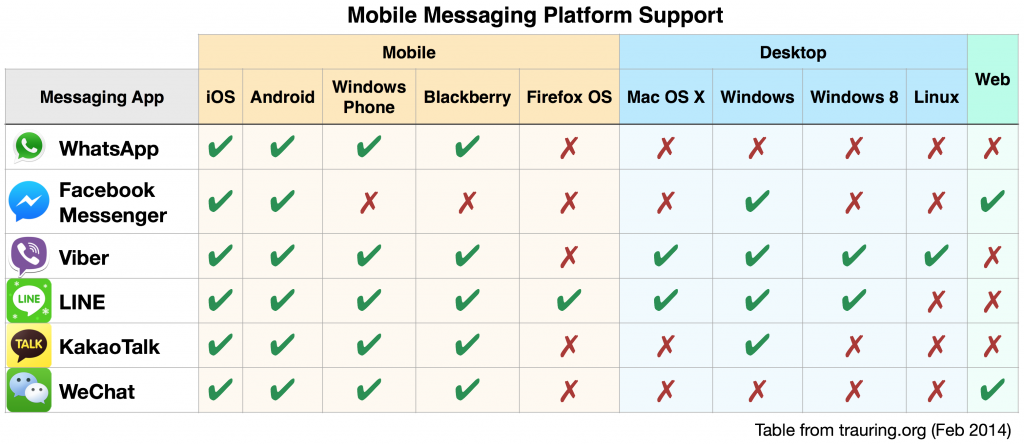
Yes, I’ve left out some platforms these apps support. Most notably Nokia S40, Symbian, and Samsung’s Bada. There’s only so much room, and I’ve added the platforms I felt were the most important. It’s important now that these platforms are supported for lower-end phones, but it’s my belief that in the future Android will swallow up the low-end market, and since Nokia is now part of Microsoft (or will be soon) I don’t expect much of a fight to keep S40 competitive.
A few things. WhatsApp is the only one that is mobile-only. They have remained very focused on what they do, and they’ve clearly done it well. They also support lots of low-end platforms not shown.
Facebook Messenger is kind of in its own category. It has very different goals than the others, although we might see these goals converge in the future. It is the only app that is a feature of a bigger site, and that makes it a bit different than the other companies. In theory it’s not even mobile-first like the others, but considering it has over 800 million mobile users, I’m including it.
Most of these apps are heading to the desktop. Viber already supports all major desktop platforms, probably due to its focus on audio and video chat, which is very convenient when one is at their desk. LINE, KakaoTalk and Facebook are all adding desktop applications.
Now let’s take a look at the features supported by these apps:
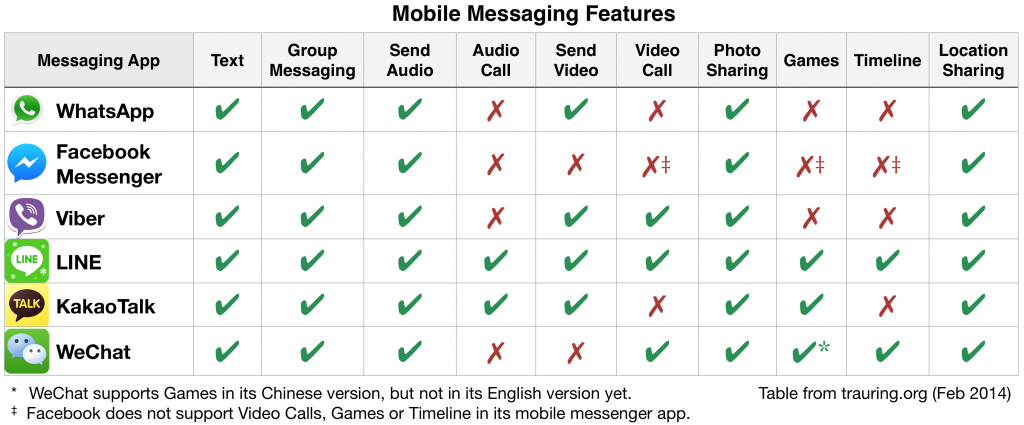
What stands out to me about the above chart is that all the apps are converging on the same feature set. Facebook is as mentioned above a bit in its own category since some of the community features that other apps are trying to build in, are part of the larger Facebook site and not supported in their messenger app. WhatsApp has the least features of the other apps, keeping with its strategy of keeping things very simple (some would argue too simple). I suspect other than Facebook and Whatsapp, we’ll be seeing all the others fill in any missing features on the above chart in the near future.
One thing I haven’t really discussed at all is how these apps make money. WhatsApp at one point charged for their app, and now give it away for free, but charge an annual $0.99/year subscription for new users past the first year. Some charge for Sticker packs and themes. Viber offers calls to regular telephones. For a great summary, the following is a chart created by Mark Watts-Jones created for his Mobile, Messaging and Marketing blog:
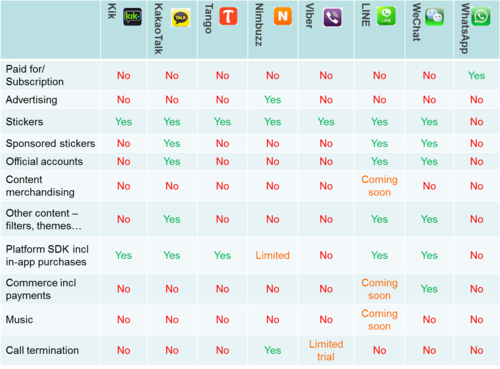
For full details on what these ten monetization strategies include, see the full article 10 ways that free messaging apps monetize. Worth noting is that WhatApp is unique in charging money for the actual app, and it is the only revenue the company has pursued until now. Only one, Nimbuzz, uses advertising. Every app except for WhatsApp sells stickers. WeChat, LINE and KakaoTalk, the three Asian apps I include in my own chart, are the three on this chart which pursue the most different monetization strategies. These include things that none of the other apps are doing, such as sponsored stickers, official accounts and other content like themes. In some ways, these can be traced to cultural acceptance of these types of monetization in China, Japan and Korea.
If you made it this far and actually read everything above, I’m impressed. Make sure to add your comments below on what you remember from the early days of Internet and mobile messaging, what your favorite messaging apps have been over time, and what you think about messaging today.

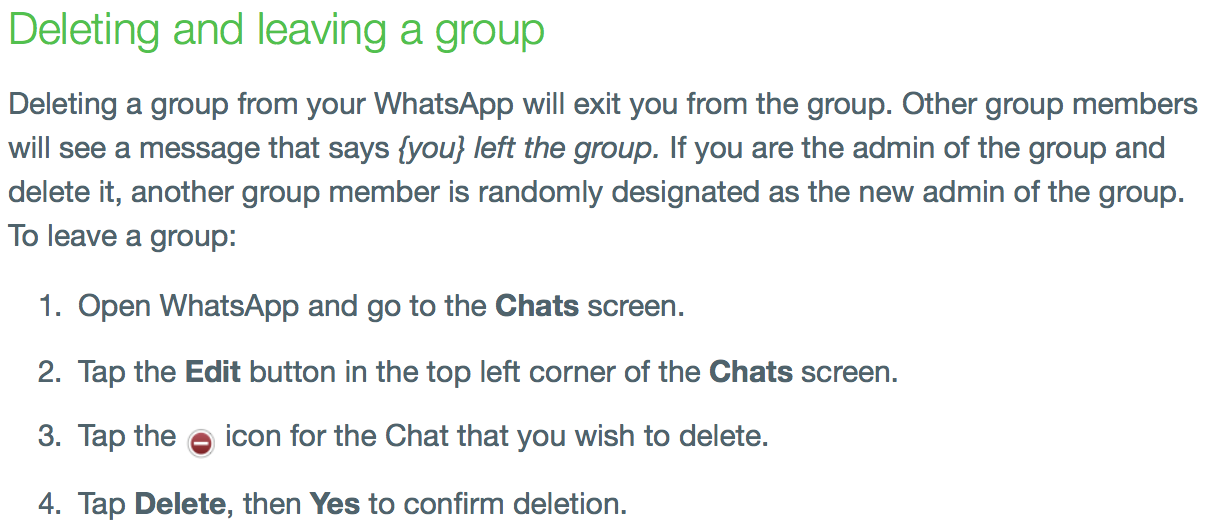
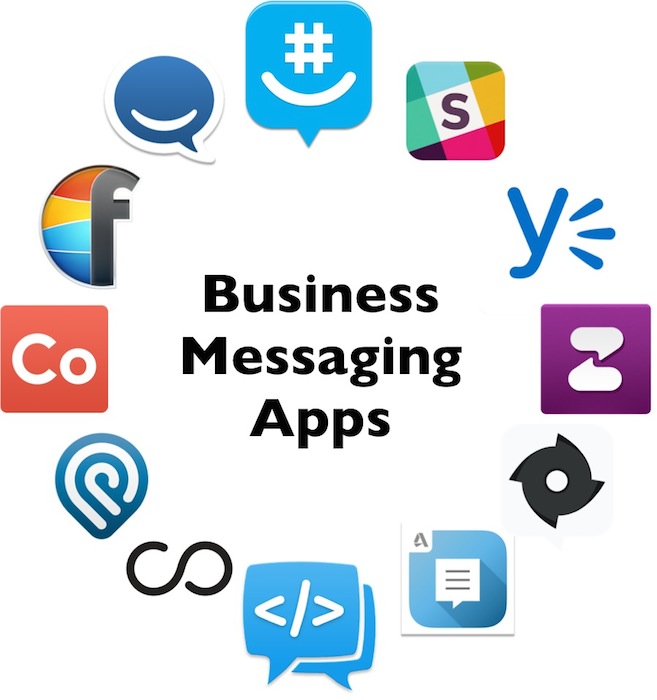
Pingback: Lots going on in the mobile messaging space - trauring.org
Pingback: What the heck are stickers? A half billion dollar and growing business... - trauring.org
Pingback: What differentiates a business messaging app? | off on a tangent